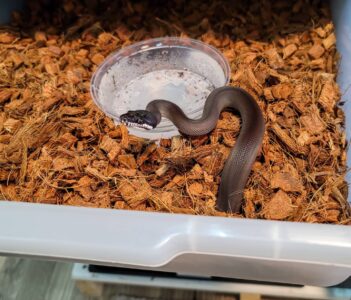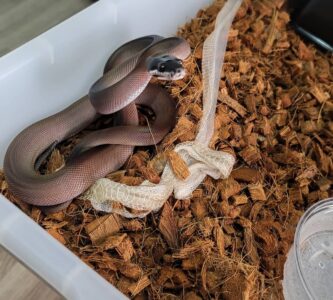Southern White Lipped Python For Sale
$1,150.00
Southern White Lipped Python
The Southern White Lipped Python (Leiopython albertisii) is a native of the dense, lush forests of Papua New Guinea. The natural habitat that is home to the white-lipped python is comprised of trees, logs, along with leaf litter as well as streams and rivers which provide drinking water sources.
White lipped pythons are terrestrial species, which means that they live upon the floor. However white lipped pythons have been often seen climbing fallen trees and logs. They are crepuscular snakes. White lipped pythons tend to be active in the afternoons and evening.
A widespread species that is found in its natural surroundings, white-lipped pythons are often captured in the wild, or kept in snake farms prior to being brought into the U.S.
Appearance and behavior
The white-lipped python is known for an intimidating look, with an eerie jet-black head and white markings on its mouth that resemble skull teeth. There are two shades of the white-lipped python.
- The northern white lipped Python has an emerald-bronze body and gold-bronze some olive.
- The Southern White Lipped Python is dark brown/black with scales with a purple hue.
In good lighting conditions the scales of the white-lipped snake take on a soap-bubble shimmering shine. The scales of the snake have nanostructures which reflect light, creating the appearance of a multi-colored shine.
Female white lipped Pythons grow larger than males.
Size and Lifespan
White lip pythons are medium snakes which grow to between 72 and 80 inches. Wild, certain females can grow to the size of 84 inches.
The life expectancy of a white-lipped python has been 30 to 40 years. If it is treated properly the snake may last longer than that.
Temperament
White-lipped Pythons are known for their aggression however, they can be better controlled when they are raised in captive.
As nippy snakes black-lipped pythons are a bit more delicate and careful handling. A bite from a white lipped python isn’t poisonous, however getting bitten by an adult snake can be painful.
White-lipped pythons must be kept in a separate area as they can be territorial and required to have their space. The cold temperatures and the wet substrate could stress the white lipped snake and create illness.
Housing White Lipped Pythons
The wild white lipped Pythons live in be found in peaty, green environments, with nearby water sources as well as fallen trees and leaves. Recreate the python’s natural habitat in captivity, by decorating your tank using logs rocks, leaves and a sandy substrate.
Place your white-lipped Python in a terrarium made of PVC or plastic. They are simple to clean and keep humidity well. Avoid using a glass enclosure since glass isn’t able to retain humidity well.
Size of the Southern White Lipped Python enclosure
The minimum size of enclosure for a Southern White Lipped Python measures 48x36x24 in. Because they are medium snakes and spend their majority of times on their feet, white-lipped Pythons require enclosures that is bigger than its height.
Lighting
The best choice of lighting for a Southern White Lipped Python enclosure would be an incandescent bulb such as an Halogen light bulb. This kind of light matches the natural sunlight the white-lipped python see outdoors.
Use only incandescent lights in the daylight hours. Set a timer that allows up to 12 hours of illumination per 24-hour time frame.
Southern White Lipped Python don’t require special UV lighting. Do not expose the tank to sunlight since this can result in the aquarium overheating, which could kill the snake.
Temperature and Humidity
White-lipped pythons are involved in thermoregulation, an activity in which the python locates a location that has the right temperature and humidity based on its metabolic requirements. In order to allow for the regulation of temperature the enclosure must have an area of thermal gradient, or a warm zone and another cooler one, that the snake can choose between.
The tank’s two-thirds area should be at a temperature of 80-85degF. A third of the tank’s surface, called the basking zone, must be at a temperature of 90 degrees. Utilize a heat pad or a heating bulb to raise the temperature of the area of basking.
Hence,
Utilize a thermometer to ensure that the temperatures are stable.
Ideal humidity levels for a Southern White Lipped Python tank is 60% to 80 percent, which is similar to the python’s swamp-like, humid natural habitat. To ensure humidity, choose the substrate that can hold on to the moisture in the air and then place a bowl of water under the source of heat and let the water evaporate and increase the humidity.
White-lipped pythons shed skin about three or four times each year. A high humidity level within the enclosure allows the snake to shed its skin at once.


















Reviews
There are no reviews yet.